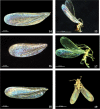Preliminary study of wing interference patterns (WIPs) in some species of soft scale (Hemiptera, Sternorrhyncha, Coccoidea, Coccidae)
- PMID: 24039524
- PMCID: PMC3763692
- DOI: 10.3897/zookeys.319.4219
Preliminary study of wing interference patterns (WIPs) in some species of soft scale (Hemiptera, Sternorrhyncha, Coccoidea, Coccidae)
Abstract
The fore wings of scale insect males possess reduced venation compared with other insects and the homologies of remaining veins are controversial. The hind wings are reduced to hamulohalterae. When adult males are prepared using the standard methods adopted to females and nymphs, i.e. using KOH to clear the specimens, the wings become damaged or deformed, an so these structures are not usually described or illustrated in publications. The present study used dry males belonging to seven species of the family Coccidae to check the presence of stable, structural colour patterns of the wings. The visibility of the wing interference patterns (WIP), discovered in Hymenoptera and Diptera species, is affected by the way the insects display their wings against various backgrounds with different light properties. This frequently occurring taxonomically specific pattern is caused by uneven membrane thickness and hair placement, and also is stabilized and reinforced by microstructures of the wing, such as membrane corrugations and the shape of cells. The semitransparent scale insect's fore wings possess WIPs and they are taxonomically specific. It is very possible that WIPs will be an additional and helpful trait for the identification of species, which in case of males specimens is quite difficult, because recent coccidology is based almost entirely on the morphology of adult females.
Keywords: Coccidae; Scale insects; WIP; interference colour patterns; males; wings.
Figures



References
-
- Buffington ML, Sandler R. (2011) The occurrence and phylogenetic implications of wing interference patterns (WIP) in the Cynipoidea (Insecta: Hymenoptera). Invertebrate Systematics. 25: 586-597. doi: 10.1071/IS11038 - DOI
-
- Gavrilov IA, Kuznetsova VG. (2007) On some terms used in the cytogenetics and reproductive biology of scale insects (Homoptera: Coccinea). Comparative Cytogenetics 1: 169-174.
-
- Giliomee JH. (1967) Morphology and taxonomy of adult males of the family Coccidae (Homoptera: Coccoidea). Bulletin of the British Museum (Natural History) Entomology, Supplement 7: 1-168.
-
- Gullan PJ, Cook LG. (2007) Phylogeny and higher classification of the scale insects (Hemiptera: Sternorrhyncha: Coccoidea). In Zhang Z-Q, Shear WA (Eds) Linnaeus Tercentenary: Progress in Invertebrate Taxonomy. Zootaxa 1668: 413-425.
-
- Gullan PJ, Martin JH. (2009) Sternorrhyncha (jumping plant-lice, whiteflies, aphids, and scale insects). 957–967 In: Resh VH, Cardé RT. (Eds). Encyclopedia of Insects. Elsevier, San Diego.
LinkOut - more resources
Full Text Sources
Other Literature Sources
